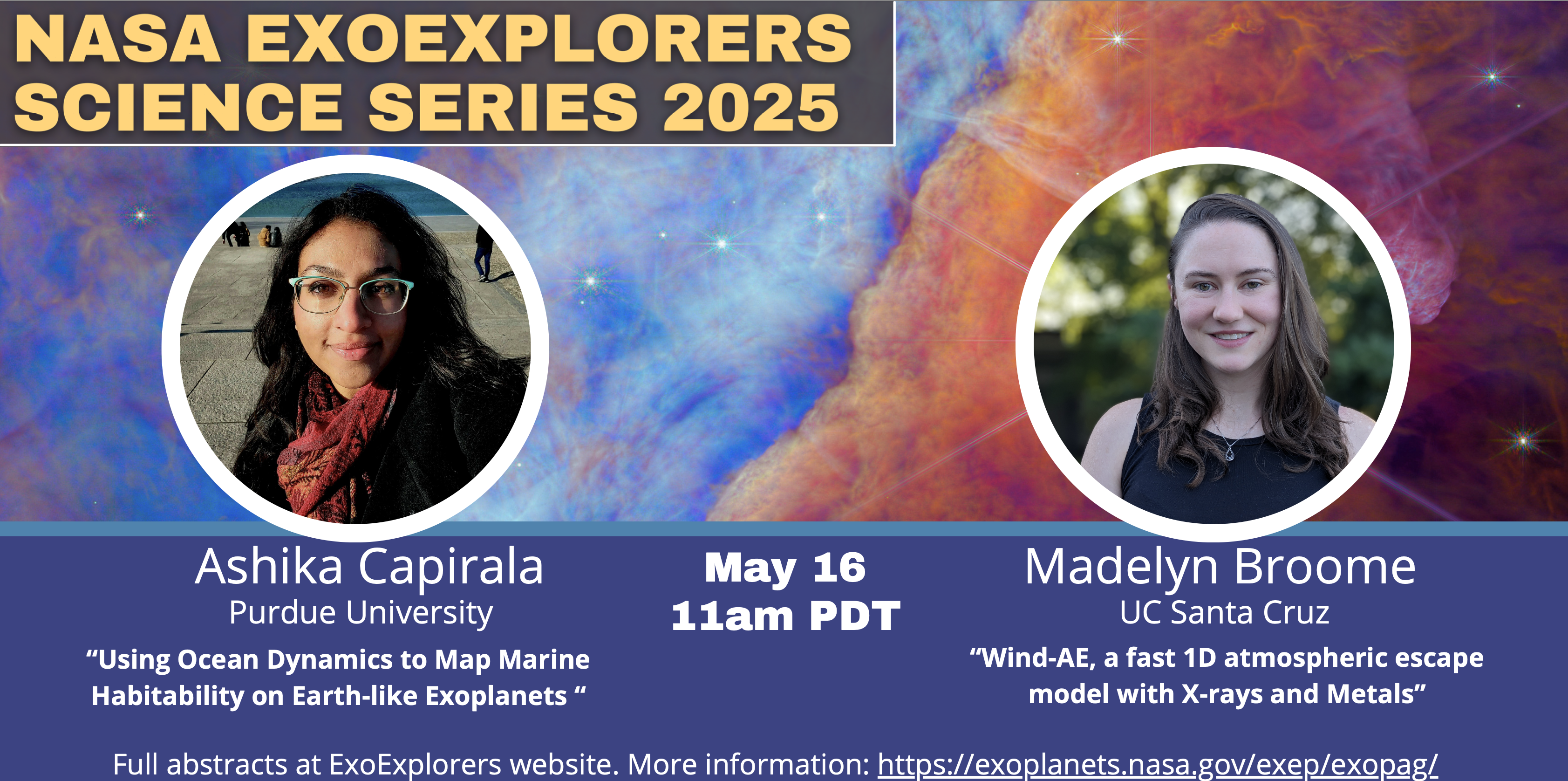Meetings & Events
ExoExplorer Science Series: Ashika Capirala and Madelyn Broome
Date:
May 16, 2025Time: 11 AM - 12 PM Pacific Daylight Time
Speaker: Ashika Capirala
Title: Using Ocean Dynamics to Map Marine Habitability on Earth-like Exoplanets
Abstract: Earth’s oceans have hosted an abundance of biological innovation, and oceans on Earth-like exoplanets may be similar hotspots for life. Habitability for complex, multicellular life requires more than just liquid water, depending additionally on circulation patterns that transport dissolved oxygen (O2) and nutrients within oceans. However, Earth's own ocean circulation has changed through time due to the slowing of Earth's rotation and the rearrangement of continents. Planetary rotation rate affects atmospheric circulation and (in turn) wind-driven ocean circulation, while continental configuration alters surface and deep ocean circulation patterns. Both rotation rate and continental configuration could vary across Earth-like exoplanets, allowing many potential landscapes of circulation and marine habitability. We use a 3D Earth system model to explore these alternate landscapes. We find that slowing rotation enhances ocean circulation and vertical mixing, leading to more efficient nutrient recycling, greater photosynthetic productivity, and higher O2 production. Stronger circulation oxygenates the deep ocean, creating potentially ‘superhabitable’ marine environments, and atmosphere-ocean interactions may also increase O2 biosignature potential on slower-rotating planets. Additionally, we find that changing continents alone can generate highly variable circulation regimes and biogeochemical outcomes. Importantly, for some configurations, the ocean can be highly deoxygenated even under detectable levels of atmospheric O2. We suggest that detecting Earth-like O2, while it may imply the presence of life, does not guarantee complex habitability.
Speaker: Madelyn Broome
Title: Wind-AE, a fast 1D atmospheric escape model with X-rays and Metals
Abstract: Throughout their lives, short-period (< 100 days) exoplanets are strongly irradiated by their host stars. Especially in the first few hundred megayears, photoionization by the young hot stars' strong XUV fluxes can drive transonic winds that outflow from these planets. The mass loss histories of these planets are essential to understanding the evolution and demographics of these populations; however, mass loss rates are not directly observable. They can only be inferred from models. To that end, we present, Wind-AE an open source 1D, multifrequency (thru to X-ray), multispecies, steady-state Parker Wind photoevaporation relaxation code based on Murray-Clay et al. (2009). The speed and reliability of the tool have allowed used in a number of investigations we will touch on including: exploring the impact of metallicity on mass loss rates; modeling observational limits of escaping H$\alpha$ on WASP-12b; constraining whether sub-Neptunes TOI 776b and c that span the period radius valley are water worlds; investigating the mystery of unusually large X-ray transits in HD189733b; and more.
Webinar Information
Join Zoom Meeting
https://caltech.zoom.us/j/88260962807?pwd=s7GH7jVBNRNZb2aVFeAZCR35Gjm6El.1
Meeting ID: 882 6096 2807
Passcode: 697257
One tap mobile
+16699006833,,88260962807# US (San Jose)
+12133388477,,88260962807# US (Los Angeles)
Dial by your location
• +1 669 900 6833 US (San Jose)
• +1 213 338 8477 US (Los Angeles)
• +1 346 248 7799 US (Houston)
• +1 312 626 6799 US (Chicago)
• +1 646 558 8656 US (New York)
• +1 301 715 8592 US (Washington DC)
Meeting ID: 882 6096 2807
Find your local number: https://caltech.zoom.us/u/kvWVsJMNt

